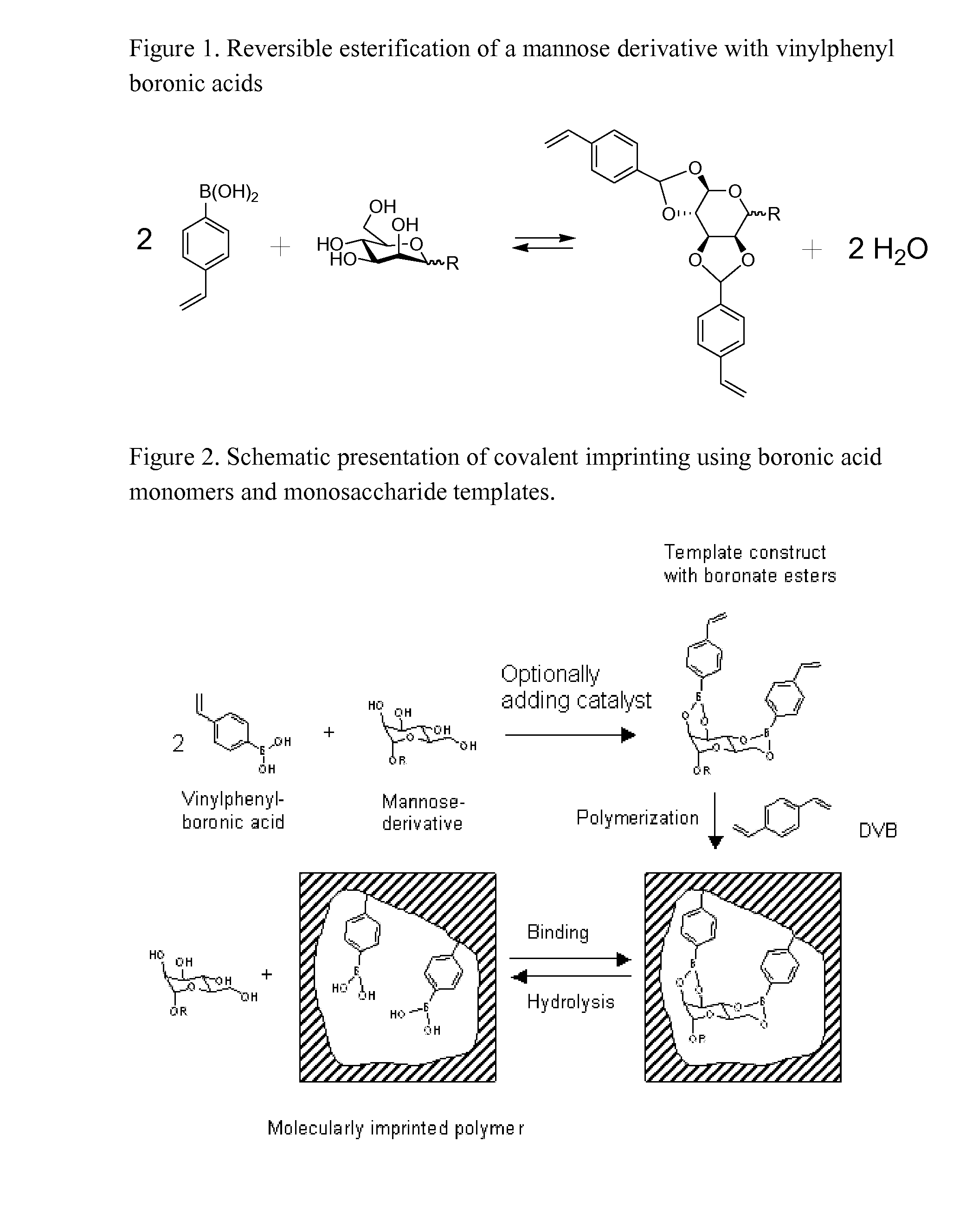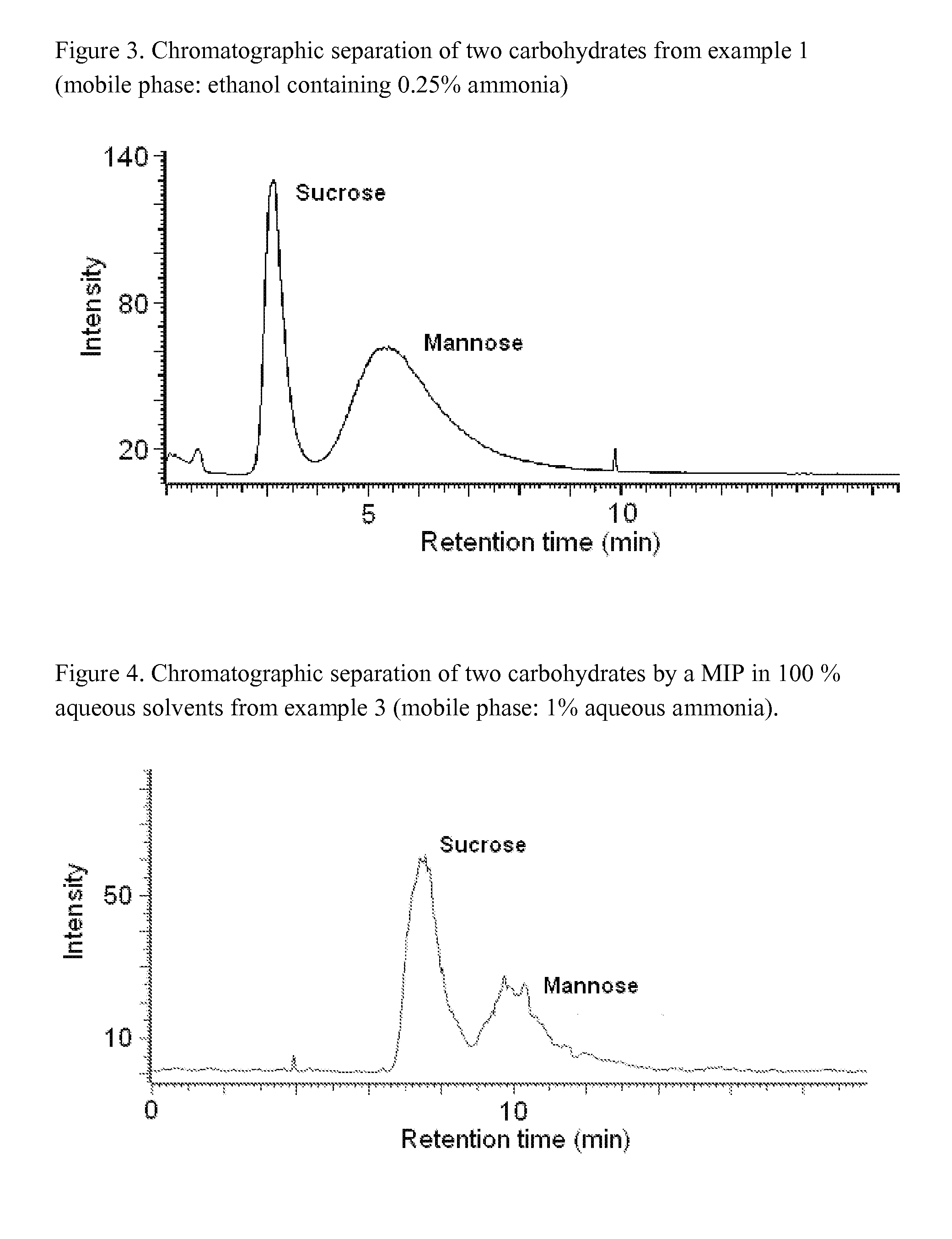Imprinted polymers
a technology of imprinted polymers and polymers, which is applied in the field of imprinted polymers, can solve the problems of inhomogeneity of binding sites, low yield of binding sites, and difficulty in ensuring solubility, and achieves the effects of promoting covalent bonding, ensuring solubility, and low solubility
- Summary
- Abstract
- Description
- Claims
- Application Information
AI Technical Summary
Benefits of technology
Problems solved by technology
Method used
Image
Examples
example 1
Aqueous Imprinting of a Saccharide with Vinylphenylboronic Acid under High pH Conditions.
[0044]Methyl-Mannoside (1 mmol) is dissolved in 5 ml of methanol containing 5% ammonia and 30% water. To this alkaline sugar solution, the monomer 4-vinylphenylboronic acid (2 mmol) and the cross-linker ethylene glycol dimethacrylate (20 mmol) are added along with an initiator (azobisdimethyl-valeronitrile). In the absence of ammonia, the components are not soluble which indicates the occurrence of solubilisation through complex formation in the presence of ammonia. Polymerization is then initiated by heat and allowed to proceed over night. Grinding followed by sieving yields a MIP powder, which is washed and dried.
[0045]In chromatographic experiments, such a MIP displays a high selectivity towards the imprinted species, as illustrated in FIG. 3.
example 2
Aqueous Imprinting of a Saccharide with Vinylphenylboronic Acid and with an Incorporated Basic Moiety.
[0046]Methyl-Mannoside (1 mmol) is dissolved in 5 ml of water containing 70% methanol. To this sugar solution, the monomer 4-vinylphenylboronic acid (2 mmol), the basic co-monomer 4-vinylbenzylamine (2 mmol) and the cross-linker ethylene glycol dimethacrylate (20 mmol) are added along with an initiator (azobisdimethylvaleronitrile). Polymerization is then initiated by heat and allowed to proceed overnight. Grinding followed by sieving yields a MIP powder, which is then washed and dried.
[0047]In chromatographic experiments, such a MIP also displays a high selectivity towards the imprinted species at lower pH values.
example 3
Aqueous Imprinting of a Saccharide with Vinylphenylboronic Acid and with an Incorporated Hydrophilic Moiety.
[0048]Methyl-Mannoside (1 mmol) is dissolved in 5 ml of methanol containing 5% ammonia and 30% water. To this basic sugar solution, the monomer 4-vinylphenylboronic acid (2 mmol), the hydrophilic co-cross-linker 1,4-bismethacryloylpiperazine (5 mmol) and the cross-linker ethylene glycol dimethacrylate (15 mmol) are added along with an initiator (azobisdimethyl-valeronitrile). Polymerization is then initiated by heat and allowed to proceed overnight. Grinding followed by sieving yields a MIP powder which is then washed and dried.
[0049]In chromatographic experiments, such a MIP displays a high selectivity towards the imprinted species in purely water-based mobile phases, as illustrated in FIG. 4.
PUM
| Property | Measurement | Unit |
|---|---|---|
| hydrophilic | aaaaa | aaaaa |
| solubility | aaaaa | aaaaa |
| ionic interactions | aaaaa | aaaaa |
Abstract
Description
Claims
Application Information
 Login to View More
Login to View More - R&D
- Intellectual Property
- Life Sciences
- Materials
- Tech Scout
- Unparalleled Data Quality
- Higher Quality Content
- 60% Fewer Hallucinations
Browse by: Latest US Patents, China's latest patents, Technical Efficacy Thesaurus, Application Domain, Technology Topic, Popular Technical Reports.
© 2025 PatSnap. All rights reserved.Legal|Privacy policy|Modern Slavery Act Transparency Statement|Sitemap|About US| Contact US: help@patsnap.com



